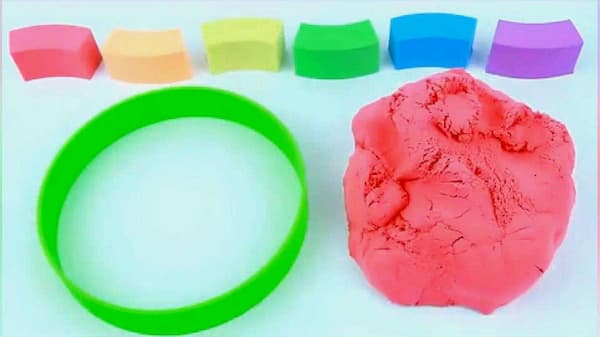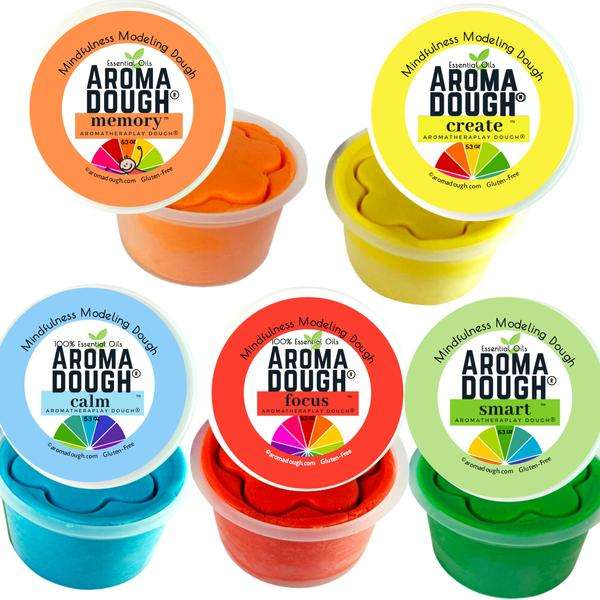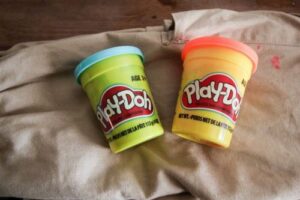
How To Make Playdough Soft Again? Easy Ways
Play-Doh becomes hard, flaky, and challenging to work with when it dries out. The putty is made up of of flour, salt, and water. You must work water into the dough in order to re-soften this substance. Continue reading for numerous tried-and-true techniques on how to make playdough soft again.
Table of Contents
Why This Is The Best Homemade Playdough Recipe?
- Making it is simple (see the recipe below for a no-cook variation).
- If kept in a bag or container with a tight seal, it will last for months.
- The texture is exquisite. It’s pleasant to work with, soft, and flexible.
Why Play Dough Worth Making At Home?
Playing with their senses is beneficial for toddlers and young children, and this is the best sensory play equipment.
It is inexpensive. When compared to store-bought dough, you are saving a ton of cash.
Knowing exactly what is in it allows you to relax knowing that you won’t be concerned if your child accidentally licks their fingers while playing with it or if it gets on their hands.
How To Make Playdough Soft Again?
Working Water Into the Dough
Pour in some water.
Put a drop of water in a tiny cup or dish and squeeze it onto the Play-Doh. Avoid soaking the dough. To reduce usage, move slowly and use one drop at a time. Try your best to fill in the gaps.
Start with more than one drop of water if there is a lot of Play-Doh to work with. Utilize one teaspoon at a time.
Play-Doh should be kneaded.
With your fingertips, incorporate the water into the dough. Play-Doh should be rolled into a ball, then stretched out, torn apart, and folded in half. After 15 to 20 seconds, if the Play-Doh is still firm, add another drop of water and continue kneading.
Be tenacious
Once the Play-Doh becomes soft again, keep adding water and kneading it. If the dough is wet and slimy, don’t worry; just keep kneading. After a few minutes, the dough ought to be as malleable and soft as fresh.
Wrap the dough in a damp paper towel
Put a wet paper towel around the dough.
Any soft, absorbent paper product, including napkins, tissues, and toilet paper, may be used. Make sure the paper towel is fully submerged in water. After that, wrap wet paper around the dough.
This is a fantastic second strategy if you’ve already tried kneading water into the dough. Though it is quicker and simpler, the kneading method is not always successful.
Ensure that the dough is fairly tightly packed. Make a ball or clump out of it. Wrapping the towel in this manner will be simple.
Place the dough in a tightly covered container
If you have a spare original plastic Play-Doh container, or a tiny Tupperware container, think about using those. To prevent the moisture from the towel from evaporating, make sure the container is tightly sealed.
Allow the Play-Doh to soak in water overnight
Before taking the Play-Doh out of the sealed container, give it at least a day. The paper towel should be removed because it is no longer damp. Squeeze, pull, and play with the play dough. Make sure it is soft enough by checking.
If the dough is still too stiff, add more water and incorporate it right away. You might be able to rehydrate the putty with enough water to balance it out because the main ingredients in Play-Doh are flour, salt, and water.
It might be time to toss the dough if multiple attempts to soften it are unsuccessful. Think about getting or making new Play-Doh. See more about How To Make Playdough Softer?
Using Water in a Bag
Break apart the fragile Play-Doh
In order for each piece to absorb water more quickly, break it up. This ought to be easy if the dough has firmed. If your Play-Doh is extremely crumbly, be careful not to spill it!
Place the Play-Doh bits in a zip-top bag
Verify that the bag can be closed and is water-resistant. Although a Ziploc bag is recommended, any non-resealable bag can be used as long as it is tied securely.
Water should be added to the Play-Doh
After you have sealed the bag, combine the dough and water. Start off cautiously with a few drops of water, then add more as you compress. The bag may become soggy and the color may bleed if you add too much water. Keep your distance and use good form. The dough should be worked on until it becomes soft.
Allow the water and Play-Doh to sit in the bag overnight
Give the dry dough time to absorb any additional water. Make sure the bag is tightly closed to prevent moisture evaporation. In a few hours, the Play-Doh should be soft, malleable, and like new! The quantity of dough and water used will determine the exact amount of time.
Only when it appears dry should you remove the Play-Doh from the bag. If the dough is still extremely wet, the color may leak off your hands.

Why Does Play Doh Become Hard If You Leave It Out?
Three basic ingredients are typically used to make playdough: flour, salt (yep, that’s why your kids might have noticed it tastes salty! ), and water.) and water.
Even the manufacturers of Play-Doh have stated that those are the three most important ingredients in their famous dough.
Water plays a very significant role in these. It keeps the dough sufficiently moist and sticky so that it can be molded without getting too messy.
Playdough will gradually lose moisture if left out in the open air due to evaporation of the water content.
If you have warm hands or a warm room, this process will proceed even more quickly.
It will also dry out more quickly in a flat, thin shape as opposed to if you leave it in a ball. That’s because a larger surface area enables simultaneous evaporation of more water. See more about How to soften Playdough (Play-Doh)
How To Fix Dried Playdough?
Which Dried Playdough Can Be Fixed
Remember that not all dried playdough can be fixed before you start investing your time and love into this activity.
In fact, it’s impossible to reshape playdough that has become completely rock-hard. It’s beyond repair.
Therefore, before beginning, check to see if the playdough is still a little bit soft in the center and you can still push your finger in. This hack works best with playdough that is crumbly and coarse.
Divide Into Small Batches
Now, divide the dried playdough into 60-gram-sized portions. Large batches are much more challenging to knead and fix!
The next few steps may need to be repeated several times if you have a lot of dry playdough.
Spray Water On The Playdough
Use a water spray bottle to evenly distribute water around the playdough ball after placing it in a bowl that can be heated in the microwave.
You need more water the dryer the playdough is.
To prevent making the dough too wet and making it sticky and gooey, start by adding 3–4 squirts of water.
Microwave The Dough
Now, soften the dough in the microwave for 10 to 15 seconds.
Transfer the food carefully into a plastic bag after removing it from the microwave.
As you knead the dough and spread the water evenly throughout, press the bag with your hands. As you go, it becomes softer and less sticky.
Take the dough out of the bag when it is manageable to handle by hand, then knead it once more. It ought to be ideal at this point, but if the dough is too wet, continue kneading it to allow the water to be absorbed.
Repeat the previous steps if the playdough is too dry to restore it to its original softness.
Naturally, you may need to add more water or rewarm the playdough in the microwave a few more times depending on how it was initially.
Downsides
Playdough can be quickly fixed with this trick for a few hours, but as soon as the kids start playing with it, it starts to dry out and lose moisture once more. To soften the dough, simply carry out the earlier steps again.
Ways To Fix Dry Playdough In A Bowl
Play Doh can be quickly rehydrated by putting the dried playdough in a bowl, but this method is messy.
Very little water should be added, and it should be incorporated into the dough gradually. As the playdough rehydrates, it might be challenging at first, but it will get simpler over time.
Since you don’t want the dough to become too sticky, always start with a small amount of water and add more as necessary.
If the outside becomes sticky, don’t be alarmed. This excess stickiness will quickly disappear after the water is absorbed by the dough.
If you care deeply about maintaining clean hands, think about having your kids participate in this activity! They might really enjoy’rescuing’ their playdough and watching it re-soften.

Ways To Revive Play Doh In A Bag
With one key difference, this approach is very similar to the first.
Your hands can stay spotless as long as you keep the dough in a sealed bag at all times up until you’re certain that all the water has been incorporated into the dough.
Put the dried play dough into a plastic bag that is watertight. You can easily work the dough from the outside by adding a splash of water and pressing out extra air.
Once more, add more water as necessary after starting with just a splash.
Revive Playdough Through A Paper Towel
If you don’t have much time or just don’t want to spend a lot of time kneading the dough with water, this is a good strategy to use.
Put the hard playdough inside a water-soaked strong paper towel. Then put it in an airtight container. The paper towel won’t dry out as a result of this.
Give it all night to do its magic! You shouldn’t have to lift a finger; the playdough should start to slowly soften from the water in the towel.
To avoid tearing the wet paper towel or having any pieces end up on the playdough, carefully pull it away when you remove the playdough.
The overnight paper towel trick should still greatly assist even if you still need to add a small amount of water and incorporate it into the dough using one of the other methods.
How To Keep Playdough From Drying Out?
Playdough Storage
Playdough dries out if it isn’t kept in an airtight container, just like homemade play “clay” made of flour and water.
- Playdough should always be returned to its original container, with the lid firmly pressed down to ensure a complete seal. Otherwise, the dough risked starting to dry out.
- If the original container is gone, keep the dough in a zippered sandwich bag or a clean, lidded plastic container, like a deli takeout container.
Reviving Semi-hard Playdough
Playdough may not be as soft as it was when it was first opened if you left it out too long or failed to completely seal the container.
For Mildly Hardened Doh
A few drops of water can be added to a clump of dough to revive it. Work the dough between your hands to incorporate the moisture. Whenever more water is required, add it.
Moderately Hardened Doh
If the whole piece of dough appears to be a little hard, wrap it in a damp paper towel and place it, along with the towel, in an airtight container. Seal the container. Within a few hours or the following day, the dough should be soft; rub it between your hands to regain its pliability.
It might be impossible to revive Playdough with moisture if it is so dry that it is cracked all over.
Conclusion
It goes without saying that the original set is beginning to dry up and crumble after a little over a year. Above gave easy ways to make playdough soft again. Have a try!


